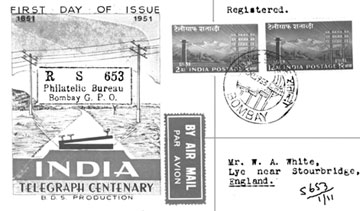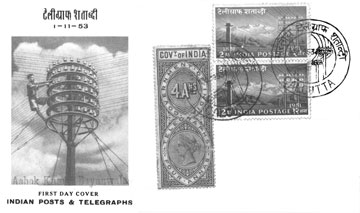On the occasion of Indian Telegraph Centenary Celebrations, the Post & Telegraphs Department issued a Souvenir Sheet showing five obsolete telegraph stamps along with two commemorative stamps. This Souvenir sheet is the first one of Independent India, issued by the Department. Four out of the five stamps were printed in issued colours and the fifth is the first Electric Telegraph stamp in black.
 |
.Regarding its price of one Rupee each, an interesting remark
was given by late Jal Cooper in December 1953 issue of “India’s
Stamp Journal”, which reads as follows:
“The sheet is more like an illustration plate distributed free by almost
all well known stamp auction houses with their sales catalogues rather than
a Souvenir Sheet (Sic)! And yet, the Indian Postal Administration has cared
to perpetuate a daylight swindle on unwary collectors by charging one rupee
for this coloured piece of paper!! Surely, this is not the proper way to fill
in the depleted coffers of the Government of India, even though there is a
great necessity to do so. Let us hope the collectors will be spread from such
a hoax next year at the time of the Centenary of Indian stamps to be celebrated
in October 1954”.
The souvenir Sheet and the two commemorative stamps depicts the figures “1851
- 1951”. If the Centenary of Telegraph was completed in 1951 why we had
the celebration in 1953? Nothing is available in black and white. Therefore,
we will scan the history and the denominations of issued postage stamps.
The first official Telegraph line was inaugurated on 1st November 1851. It
connected Calcutta with Diamond Harbour, a distance of 48kms, along the shipping
route in the Hooghly. Kedgeree and Mayapore were other two places which were
also connected with this line. An interesting incident is recorded by Ilyas
Patel & Dhananjay Desai in his book “Indian Telegraphs / 1851-1914”,
which reads “Before the official inauguration took place on November
1, 1851, a deep depression took place in the Bay of Bengal on October 23 and
the newly installed Telegraphic Line started communicating information immediately
to Fort william. The severity of the storm and its forecast was so precisely
communicated on this line and in such quick time that it not only outdated
the semaphore signalling system but silenced all the critics of Electric Telegraph”.
The success of the telegraph line persuaded E. I. Co., to construct telegraph
lines in between important towns of India. The first work in between Calcutta
and Agra started on 1st November 1853. Thus, we conclude that 1st November
had an important role in Telegraph History of India.
The Commemorative Postage Stamps consist of two denomination.
The first is 2 annas (inland letter mail) and the other one is 12 annas (purported
to be Air Mail charges in between India and UK).But the air mail charges in
between India & UK, changed on and from 1st April 1953, from 12 annas
to 14 annas. That is why Everest stamps issued on 2nd October 1953, had 14
annas value, which represented the then current Air Mail rate in between India
and UK. If these Telegraph Centenary Stamps were printed afterwards, it should
be of 14 annas instead of 12 annas. It means that these Centenary Stamps were
printed well in advance before 1st April 1953. It also appears that the Department
must have forgotten to issue in 1951 and whenever they realized the mistake,
they immediately printed the same and rightly inscribed the date 1851 - 1951
in the design. After printing of the stamps, the Department must have tried
to finalize a particular date to issue the same. And 1st November was the
only suitable date, as per historical reasons discussed above
As usual the stamps and the First Day Covers were available from all important
post offices throughout India but special cancellation was available only
from Philatelic Bureaux. Private F. D. Covers are also found used. Even obsolete
Telegraph stamps were also found used on First Day Covers, along with postage
stamps.
 |
 |
 |
 |
![]() 1. The above First
Day cover is issued by Indian Posts & Telegraphs Department as “SPECIMEN”.
1. The above First
Day cover is issued by Indian Posts & Telegraphs Department as “SPECIMEN”.
![]() 2. The Privately printed F.D.C was
mailed from Bombay to England on 1st November 1953 through Register Post by
affixing 14 annas postage stamps of “ INDIAN TELEGRAPH CENTENARY”.
(Both value)
2. The Privately printed F.D.C was
mailed from Bombay to England on 1st November 1953 through Register Post by
affixing 14 annas postage stamps of “ INDIAN TELEGRAPH CENTENARY”.
(Both value)
![]() 3. The F.D.C with two postage stamps
of Indian Telegraph Centenary was cancelled at Calcutta GPO by Special Cancellation
along with 4 annas Telegraph Stamp. (Aqua-marine colour)
3. The F.D.C with two postage stamps
of Indian Telegraph Centenary was cancelled at Calcutta GPO by Special Cancellation
along with 4 annas Telegraph Stamp. (Aqua-marine colour)
![]() 4. The F.D.C with two postage stamps
of Indian Telegraph Centenary was cancelled at Calcutta GPO by Special Cancellation
along with 8 annas Telegraph Stamp. (Dark brown colour)
4. The F.D.C with two postage stamps
of Indian Telegraph Centenary was cancelled at Calcutta GPO by Special Cancellation
along with 8 annas Telegraph Stamp. (Dark brown colour)